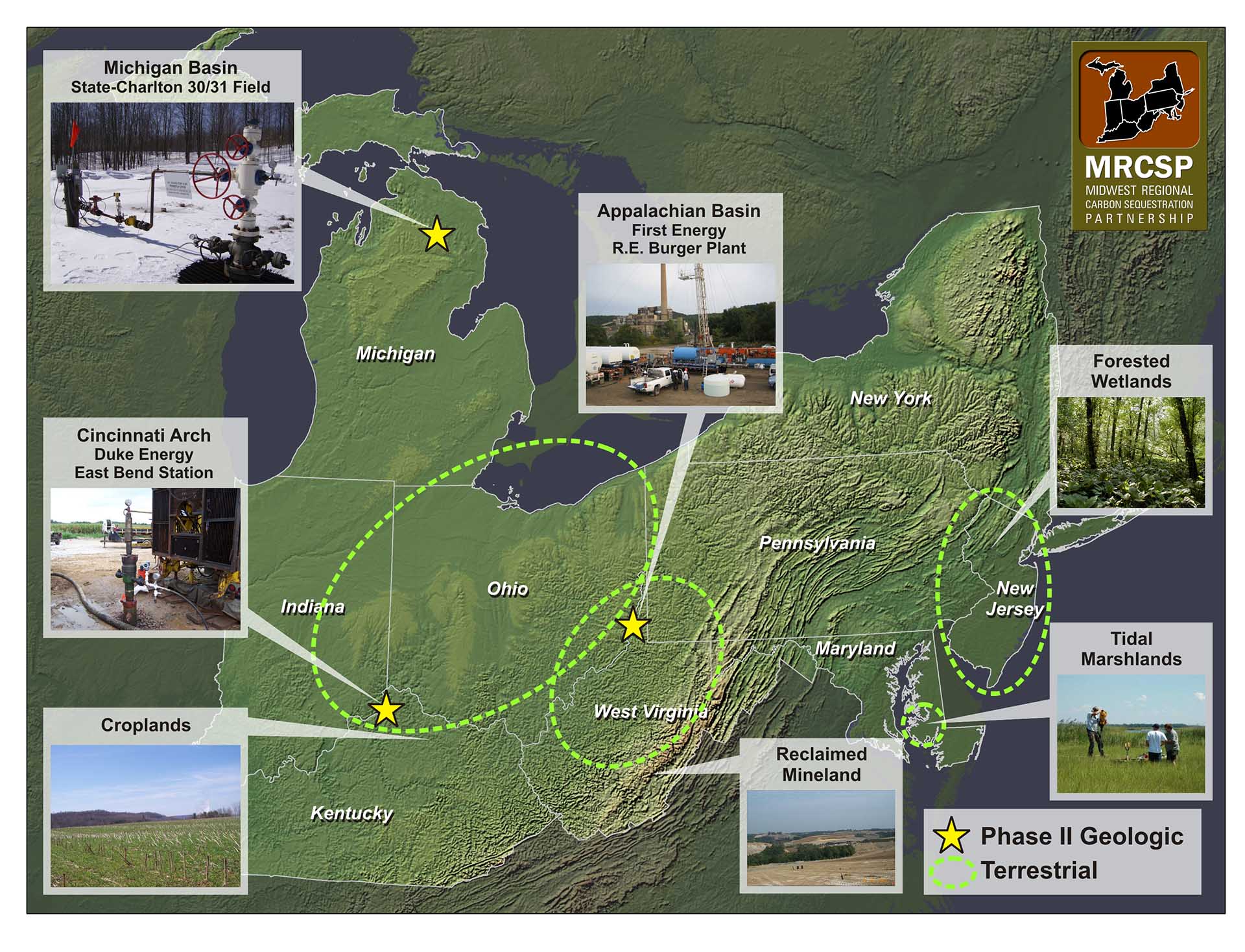Carbon Storage Atlas
- Scale-Up to Phase II
- Regional Accomplishments
- Story of Interest
- Research vs. Commercial
- Links to EDX
- Sites
- Partners
Scale-Up to Phase II
The Midwest Regional Carbon Sequestration Partnership (MRCSP) Phase I project ended with seven states and numerous organizations. In Phase II, it grew to 9 states (Indiana, Kentucky, Maryland, Michigan, New Jersey, New York, Ohio, Pennsylvania, and West Virginia) and 40 organizations from the research community, energy industry, universities, non-government, and government organizations. Phase II transitioned from paper-only studies to the planning and implementation of seven field tests, which covered multiple geographic provinces.
Three geologic pilot-scale injection tests were conducted, one in each of the three major geologic provinces of the region: the Michigan Basin, Appalachian Basin, and Cincinnati Arch. Four terrestrial field tests were conducted in land types characteristic of the heterogeneity of the region: croplands, reclaimed mine lands, reclaimed marshlands, and forested wetlands. The full lifecycles of these tests were experienced, including site screening, site selection, permitting, modeling/monitoring, injection, and closeout. The technical and logistical complexity was significantly increased from Phase I to the field programs in Phase II, with many lessons learned for future commercial scale-up.
Regional Accomplishments
The Midwest Regional Carbon Sequestration Partnership (MRCSP) Phase II effort was the first time within the region that carbon dioxide (CO2) storage in both geologic reservoirs and terrestrial soils was demonstrated in the field. The saline reservoirs were composed of sandstones and carbonates in a variety of depositional settings. The pre-existing geologic understanding was limited in most cases, adding uncertainty. The field site locations offered a chance to interact with three regulatory jurisdictions and distinctive stakeholder surroundings, and provided insights for use by the U.S. Environmental Protection Agency (EPA) in developing Class VI CO2 storage well standards. Overall, three test wells were successfully drilled and CO2 was injected, which included obtaining the cooperation and support of a host site willing to allow use of land and facilities and to lend staff support for the conduct of the test, obtaining all legally required permits through state and federal agencies having jurisdiction, and extensive outreach. This work was supplemented by the geologic mapping team from nine states and numerous terrestrial storage field tests.
The diverse spread of the program was extremely useful in exposing numerous new stakeholders to carbon capture and storage (CCS), including the successes, challenges, and uncertainties inherent in developing CO2 storage locations. The overall outcome was that CO2 storage can be conducted at large-scale in multiple reservoirs in the region. However, it also illustrated the need for enhanced regional characterization to better understand storage resources, heterogeneities, selection of site-specific monitoring technologies, and development of state and federal policies to enable deployment.
Story of Interest
The Midwest Regional Carbon Sequestration Partnership (MRCSP) Phase II Program was spread across three geologic tests and four terrestrial tests. This regional diversification exposed a large number of new stakeholders to carbon capture and storage (CCS) and field projects. For most people that worked on the Phase II project, it was the first-time seeing carbon dioxide (CO2) injection in action or learning about the impact of terrestrial carbon management practices. Two of the MRCSP geologic field tests were completed at active power plants and the other test site was at an active CO2 enhanced oil recovery (EOR) field with CO2 from natural gas processing. Safety was a high priority at the power plant sites, as they were not familiar with drilling deep test wells. This required significant bridging of safety protocols between power generation and oil/gas industries. During a site tour, a curious member of the visiting group blew on a CO2 gas sensor on the surface wellhead to test its sensitivity, which caused alarms to sound and injection to stop, as intended. The field tests also illustrated how variable geology is in the MRCSP region. Two of the geologic sites had high injectivity, but the rock formations were not suitable for CO2 injection at another site (resulting in the first “dry well” in the U.S. Department of Energy’s [DOE] Carbon Storage Program) in a deeper portion of the Appalachian Sedimentary Basin. The field injection tests and outreach exposed more stakeholders to CCS, establishing confidence and familiarity with CCS technology in the region. Finally, the field tests attracted a large-number of young staff interested in making CCS a career, representing the first wave of CCS workforce development.
Research vs. Commercial
Phase II field tests were pilot-scale injection tests that were permitted as U.S. Environmental Protection Agency Underground Injection Control (UIC) experimental Class V injection wells. The amount of carbon dioxide (CO2) injected at each site was small, so the resulting area of review was smaller and permitting, stakeholder impact, and post-injection closeout were easier than would be needed for a commercial-scale injection site. For a commercial-scale site, the geology is expected to be more heterogeneous and the injectivity would be the largest concern. A commercial-scale injection site would also require more integration of carbon capture and storage (CCS) technologies from site characterization, injection, and monitoring, as well as larger areas of permitting and pore-space access. One lesson learned from the field tests is that in deep, mature basins, such as those in the Midwest Regional Carbon Sequestration Partnership (MRCSP) region, carbonates could be a significant storage opportunity.
Sites
Partners
AEP
AJW, Inc
Babcock and Wilcox (B&W)
Baard energy
BP
Center for Energy and Economic Development
Chicago Climate Exchange
CONSOL Energy
Core Energy
DTE Energy
Duke Energy
FirstEnergy
Indiana Geological Survey and Indiana University
Kentucky Geological Survey and University of Kentucky
The Keystone Center
Leland Stanford Junior University
Maryland Geological Survey
National Regulatory Research Institute (nrri)
Office of the Ohio Consumers Council
Ohio Coal
Ohio Corn
Ohio Environmental Council
Ohio Geological Survey
Ohio Soybean Council
Ohio State University
Pacific Northwest National Laboratory
Pennsylvania Geological Survey
Praxair
Schlumberger
University of Maryland
West Virginia University
Western Michigan University




